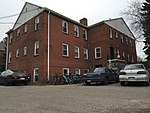Michigan State Medical Society
1866 establishments in Michigan1959 establishments in MichiganAmerican Medical AssociationBuildings and structures in Ingham County, MichiganEast Lansing, Michigan ... and 6 more
Healthcare in MichiganMinoru Yamasaki buildingsModernist architecture in MichiganOffice buildings completed in 1959Organizations based in MichiganOrganizations established in 1866
The Michigan State Medical Society (MSMS) is a professional association representing more than 15,000 physicians in Michigan. Incorporated on June 5, 1866, MSMS is a non-profit, membership organization of physicians, graduates completing residency programs, and medical school students. MSMS is the state affiliate of the American Medical Association. The Michigan State Medical Society publishes the weekly Medigram eNewsletter and the bi-monthly Michigan Medicine® magazine.
Excerpt from the Wikipedia article Michigan State Medical Society (License: CC BY-SA 3.0, Authors).Michigan State Medical Society
Abbot Road, East Lansing
Geographical coordinates (GPS) Address Nearby Places Show on map
Geographical coordinates (GPS)
| Latitude | Longitude |
|---|---|
| N 42.7474 ° | E -84.4844 ° |
Address
Abbot Road
48823 East Lansing
Michigan, United States
Open on Google Maps









